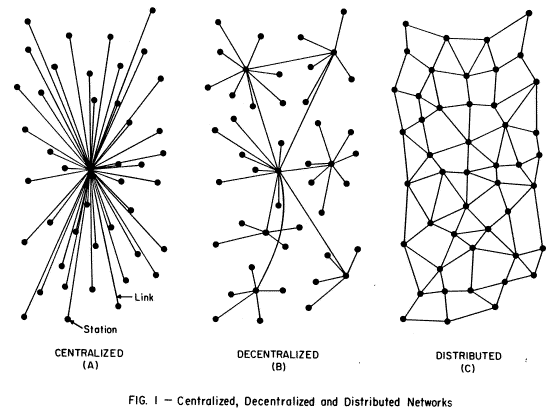 Turkey shut down Twitter today. Prime Minister Recep Tayyip Erdoğan announced, “We now have a court order. We’ll eradicate Twitter. I don’t care what the international community says. Everyone will witness the power of the Turkish Republic.” (Hurriyet Daily News) He also said Turkey will “rip out the roots” of Twitter. (Washington Post)
Turkey shut down Twitter today. Prime Minister Recep Tayyip Erdoğan announced, “We now have a court order. We’ll eradicate Twitter. I don’t care what the international community says. Everyone will witness the power of the Turkish Republic.” (Hurriyet Daily News) He also said Turkey will “rip out the roots” of Twitter. (Washington Post)
Those roots are in the Internet. This is a good thing. Even if Turkey rips the roots out of the phone and cable systems that provide access to the Net, they can’t rip out the Net itself, because the Net is not centralized. It is distributed: a heterarchy rather than a hierarchy. At the most basic level, the Net’s existence relies on protocols rather than on how any .com, .org, .edu or .gov puts those protocols to use.
The Net’s protocols are not servers, clouds, wires, routers or code bases. They are agreements about how data flows to and from any one end point and any other. This makes the Internet a world of ends rather than a world of governments, companies and .whatevers. It cannot be reduced to any of those things, any more than time can be reduced to a clock. The Net is as oblivious to usage as are language and mathematics — and just as supportive of every use to which it is put. And, because of this oblivity, The Net supports all without favor to any.
Paul Baran contrasted centralized systems (such as governments), decentralized ones (such as Twitter+Facebook+Google, etc.) and distributed ones, using this drawing in 1964:
Design C became the Internet. Except the Internet is actually more like D in this version here:

Because on the Internet you don’t have to be connected all the time. And any one node can connect to any other node. Or to many nodes at once. Optionality verges on the absolute.
The distributed model (C) appealed to military folks because it was the best design for surviving attack. Even in a decentralized system there are central points of vulnerability where a government could spy on traffic or knock out a whole service.
The “attack surfaces” of a distributed system are no larger than a single node or a single connection, so it’s much harder to bring the whole thing down. This is why John Gillmore says “The Internet interprets censorship as damage and routes around it.”
No doubt this is happening right now in Turkey, just as it is in China and other countries that block sites and services on the Net. It might not be easy, but it is do-able by design. That design is not about hard, fixed and administrated lines, but on voluntary connections, or what Bob Frankston calls ‘DIY connectivity’.
Twitter’s centralized nature makes it a dot in the star-shaped designs of A and B. That dot becomes a black hole when powerful actors like the Turkish and Chinese governments “eradicate” it. We need to bear this in mind when we design and use centralized systems — and even decentralized ones, such as we have with Twitter, Google, Facebook and other “social” walled gardens, which together comprise something that looks and works on the model of B rather than C. But it is also essential to understand that D is what we have underneath it all, and it is based on Paul Baran’s distributed model (C).
It also helps to recognize that some things — such as being social with each other — do not require centralized systems, or even decentralized ones. They can be truly distributed, heterarchical and voluntary. Just as we have freedom of speech and association in any free society, we should have the same on the Net. And, at the base level, we do.
But this isn’t easy to see, for five reasons:
- We do need centralized systems for doing what only they can do
- Existing building methods and materials make it easy
- The internet is also a “network of networks” which at the backbone and “provider” level (the one you access it through) is more like a combination of B and C — and, because you pay providers for access, it’s easy to ignore C as the virtuous base of the whole thing
- After eighteen years of building centralized systems (such as Twitter) on the Net, it’s hard for most people — even geeks familiar with the Net’s base design — to think outside the box called client-server (and some of us call calf-cow)
A great way to avoid the black hole of centralization is to start from the fully distributed nodes that each of us are, designing and building first person technologies. And I have a specific one to recommend, from Customer Commons:
This is Omie:
She’s the brainlet of Customer Commons: She is, literally, a clean slate. And she is your clean slate. Not Apple’s. Not Google’s. Not some phone company’s.
She can be what you want her to be, do what you want her to do, run whatever apps you want her to run, and use data you alone collect and control.
Being a clean slate makes Omie very different.
On your iPhone and iPad you can run only what Apple lets you run, and you can get only from Apple’s own store. On an Android phone you have to run Google’s pre-loaded apps, which means somebody is already not only telling you what you must do, but is following you as well.
Omie uses Android, but bows to Google only in respect of its intention to create an open Linux-based OS for mobile devices.
So Omie is yours, alone. Fully private, by design, from the start.
Omie needs crowdfunding. More specifically, she needs somebody who is good at doing crowdfunding videos, to help us out. We have the script. If you’re up for helping out, contact me. I can be DM’d via @dsearls, or emailed via my first name @ my last name dot com. Thanks!


Leave a Reply